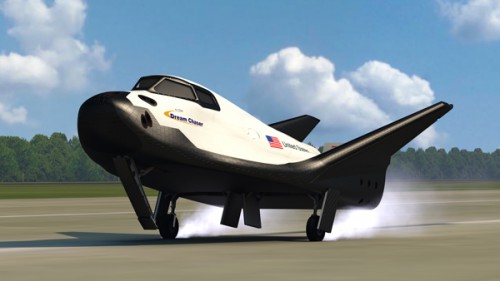
The Dream Chaser space plane, in development by Sierra Nevada Corporation (SNC) under NASA’s commercial efforts to deliver astronauts to the International Space Station, is one milestone closer to launch.
Dream Chaser has wrapped up the Integrated Systems Safety Analysis Review, giving NASA reports detailing hazard, safety, and reliability plans for the major elements that relate to the United Launch Alliance Atlas V rocket, which will be used to send Dream Chaser to orbit—the integrated crew transportation system and the Dream Chaser space plane itself.
Under NASA’s Commercial Crew integrated Capability (CCiCap), the Louisville, Colo.-based company is working to have the craft fly crew no earlier than 2017.
“Safety review milestones are critical to ensuring safety and reliability techniques, and methods are incorporated into space systems design,” said NASA CCP Manager Ed Mango. “NASA’s participation in these reviews provides our partners with critical design experiences from past human spaceflight activities.”
SNC is developing its Dream Chaser Space System under NASA’s Commercial Crew Integrated Capability (CCiCap) initiative, which is intended to lead to the availability of commercial human spaceflight services for government and commercial customers.
“Dream Chaser is making substantial progress toward flight with the help of our NASA team,” said Mark Sirangelo, head of SNC’s Space Systems. “The ability to openly exchange information through the work on these CCiCap milestones is invaluable for many reasons, such as communicating Dream Chaser development plans and receiving timely feedback from NASA, all of which help to improve our design and maximize safety and reliability. As we begin our flight test program, we have a better and stronger program due to our partnership with NASA.”
SNC is hoping to conduct the first-ever free flight test of a flight test article of Dream Chaser this month at NASA’s Dryden Research Center in California. Currently the test craft is being prepared to be shipped to the center. If all goes according to plan, the test should provide SNC with valuable data about the gliding characteristics of the spacecraft as it conducts an approach and landing at a runway.
Dream Chaser is based off of NASA’s HL-20 lifting body design. SpaceDev began developing the concept and was one of the initial design’s considered under NASA’s Vision for Space Exploration, which was announced in 2004. It also was submitted in the early rounds of NASA’s Commercial Orbital Transportation Services, or “COTS,” contract. In 2007, SpaceDev and United Launch Alliance announced that they were collaborating to fly this version of Dream Chaser on an ULA Atlas V booster.
The very next year SpaceDev was bought by Sierra Nevada Corporation, who continued to pursue the project. NASA awarded $20 million under the first phase of the space agency’s commercial crew program in 2010. Since that time SNC has continued to develop and test Dream Chaser, with NASA approving the winged spacecraft for awards in the second and third rounds of its commercial crewed efforts.
Want to keep up-to-date with all things space? Be sure to “Like” AmericaSpace on Facebook and follow us on Twitter:@AmericaSpace




Dream Chaser bears some resemblance to the Soviet BOR test model flown in the Buran shuttle development.
It will be cool to hear the experiences of someone that’s reentered on both a fire breathing dragon and the dreamchaser.